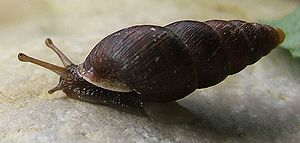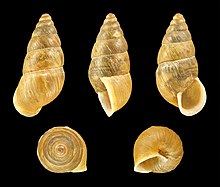Mountain wolverine snail
| Mountain wolverine snail | ||||||||||||
|---|---|---|---|---|---|---|---|---|---|---|---|---|

Mountain wolverine snail ( Ena montana ) |
||||||||||||
| Systematics | ||||||||||||
|
||||||||||||
| Scientific name | ||||||||||||
| Ena montana | ||||||||||||
| ( Draparnaud , 1801) |
The mountain wolverine snail ( Ena montana ), also referred to by some authors as the forest wolverine snail or the mountain tower snail , is a type of snail belonging to the wolverine family (Enidae) from the suborder of the land snails (Stylommatophora).
features
The housing is conical and has 7 to 8 turns, which are rather flat arched at the periphery. Adult they reach a height of 14 to 17 millimeters and a thickness (width) of 6 to 7 millimeters. The mouth rim is bent outwards, but only slightly thickened. A callus has developed on the top of the mouth instead of a lip. The edge of the mouth is pale pink to white. The surface of the case is covered with strong, partly grained, somewhat irregular strips of growth and only slightly shiny. Occasionally the growth strips are crossed by fine spiral lines. The color varies from light to dark brown, the apex can also be almost white due to fading. The shell is faintly translucent. The umbilicus is very narrow and stitch-shaped, and in the spindle area covered by the bent-over mouth rim.
The soft body of the animal is light brown, dark brown to purple brown with darker spots on the top and head of the animal. Occasionally melanistic specimens also appear. The head and eye stalks are usually darker than the body.
In the reproductive system, the spermatic duct (vas deferens) branches off from the egg duct (spermoviduct). He is very long and thin. It opens into the very long epiphallus a little below the apex ; the apex of the epiphallus is drawn out into a short, conical flagellum. A short conical blind sack (epiphallus blind sack or epiphallus caecum) sits approximately in the middle of the total length of the epiphallus. The thickness of the epiphallus varies little over its entire extent. The epiphallus / penis transition is marked by an increase to twice the thickness of the epiphallus. The penis is very short compared to the epiphallus. The very long penis appendix starts in the lower half of the penis and can be divided into five sections of different thickness. The lower part is a little as thick as the penis itself. This is followed by a very short part that is about half the thickness of the first part. Then the thickness decreases again significantly. The fourth section is a little thinner and gradually goes into the end part, which is elongated-club-shaped. The retractor muscle splits into two strands, one of which attaches to the penis, the other strand to the lower, strongly thickened part of the penile appendix. In the female genital tract, the free fallopian tube is very long and the vagina is very short. The seminal vesicle sits on a long stem. Just before the small elongated bladder, a very long diverticulum branches off, reaching approximately two-thirds the length of the pedicle.
Geographical distribution, habitat and way of life
The species is widespread in Central Europe. In the east the distribution area extends to Central Russia and the Carpathians, in the west to eastern France and the western Alps. From Western Europe only isolated occurrences in western France and southern England as well as the Pyrenees are known.
The mountain wolverine snail occurs in old forests, in the litter and in the foliage, between stones and rocks, and less frequently in rows of old hedges and bushes. In wet weather it often climbs up trees and stones. It prefers to live in the middle and high mountains, occasionally also in the lowlands. In the Alps it rises to an altitude of 2000 m. It is generally rather rare and the occurrences are very isolated. Little is known about diet. It seems to feed on withered plants and decomposing organic matter. The weathered surfaces are also grazed by dry stems. They spend the winter, often several specimens together, in hiding under stones or rotted wood. During the winter rest, the housing is closed with a diaphragm.
Taxonomy
The species was first scientifically described by Jacques Philippe Raymond Draparnaud as Bulimus montanus in 1801. It is the type species of the genus Ena Turton, 1831. There are at least two synonyms.
Danger
The mountain wolverine snail is on the pre-warning list in Germany.
supporting documents
literature
- Klaus Bogon: Land snails biology, ecology, biotope protection. 404 p., Natur Verlag, Augsburg 1990, ISBN 3-89440-002-1 (p. 148/9)
- Rosina Fechter, Gerhard Falkner: Mollusks. 287 p., Mosaik-Verlag, Munich 1990 (Steinbach's Nature Guide 10). ISBN 3-570-03414-3
- Ewald Frömming: Biology of the Central European Landgastropods. 404 S.- Duncker & Humblot, Berlin 1954.
- Jürgen H. Jungbluth, Dietrich von Knorre: Common names of land and freshwater mollusks in Germany (Gastropoda et Bivalvia). Mollusca, 26 (1): 105-156, Dresden 2008. ISSN 1864-5127
- Michael P. Kerney, Robert AD Cameron, Jürgen H. Jungbluth: The land snails of Northern and Central Europe. 384 pp., Paul Parey, Hamburg & Berlin 1983. ISBN 3-490-17918-8
- Francisco W. Welter-Schultes: European non-marine molluscs, a guide for species identification = identification book for European land and freshwater mollusks. A1-A3 p., 679 p., Q1-Q78 p., Planet Poster Ed., Göttingen 2012, ISBN 3-933922-75-5 , ISBN 978-3-933922-75-5 (p. 132)
Individual evidence
- ^ Fromming, Landgastropoden, p. 53
- ^ Jacques Philippe Raymond Draparnaud: Histoire naturelle des mollusques terrestres et fluviatiles de la France. Ouvrage posthumous. SI-VIII, pp. 1-134, plates 1-13, Paris, Montpellier, Plassan, Renaud. Online at www.biodiversitylibrary.org: p. 60
- ↑ Fauna Europaea
- ^ Vollrath Wiese: The land snails of Germany. 352 pp., Quelle & Meyer, Wiebelsheim 2014 ISBN 978-3-494-01551-4 (p. 115)
On-line
Web links
- Molluscs of Central Europe
- Ena montana inthe IUCN 2013 Red List of Threatened Species . Posted by: Neubert, E., 2011. Retrieved February 15, 2014.
